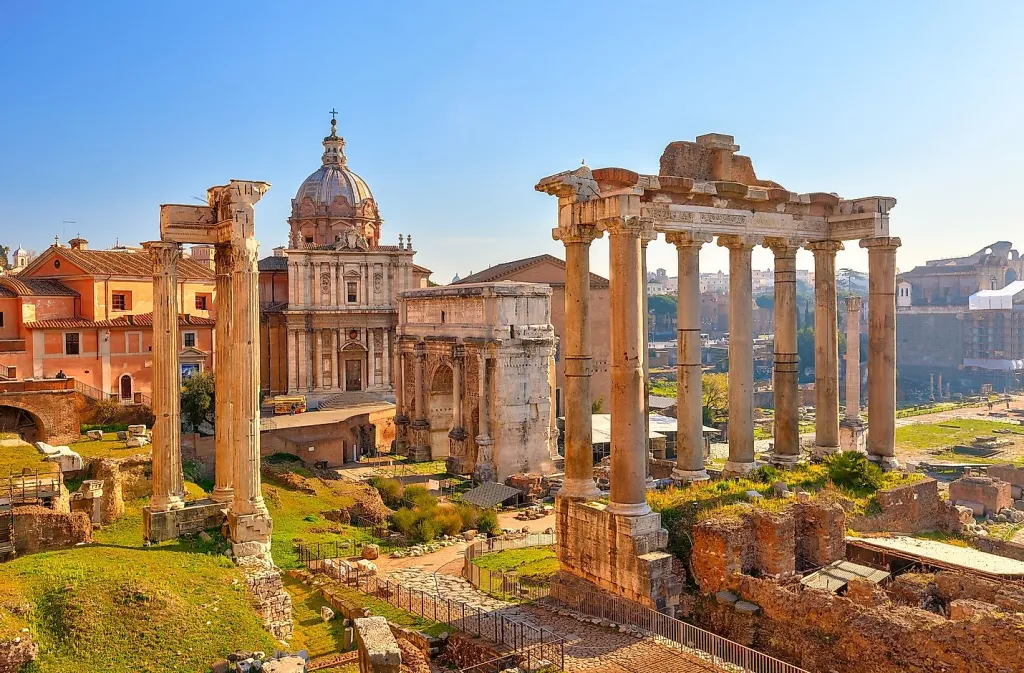Roman architecture is one of ancient civilization’s most influential and enduring legacies. From monumental structures like the Colosseum and the Pantheon to practical feats of engineering such as aqueducts and roads, Roman architecture has shaped how societies design and construct their buildings. This article explores Roman architecture’s remarkable achievements, defining characteristics, and lasting impact on the world.
The Origins and Influences of Roman Architecture
Roman architecture flourished during the Roman Republic (509–27 BCE) and the Roman Empire (27 BCE–476 CE) and did not emerge in isolation. The architectural traditions of the Etruscans and the Greeks heavily influenced it. The Etruscans, an ancient civilization in central Italy, provided the Romans with essential construction techniques, including arches. The Romans borrowed elements of classical architecture from the Greeks, such as columns and decorative motifs, while adding their distinct innovations.
The Romans’ ability to assimilate and improve upon the techniques of earlier cultures laid the foundation for their architectural achievements. They combined practicality with grandeur, creating structures that were not only functional but also awe-inspiring.
The Revolutionary Use of Concrete in Roman Architecture
One of Roman architecture’s most significant contributions to the world was the widespread use of concrete. Roman concrete, or opus caementicium, was a mixture of lime, volcanic ash, and rubble, which made it incredibly durable and versatile. Unlike stone, concrete allowed Roman architects to create more complex structures with curved shapes and open spaces.
The invention of concrete enabled the construction of iconic Roman buildings like the Pantheon, which features a massive unreinforced concrete dome that remains the largest of its kind in the world. Concrete’s flexibility also allowed for the development of vaults, domes, and arches, which became hallmarks of Roman architecture and set the stage for architectural advancements in later centuries.
The Mastery of the Arch and Vault in Roman Architecture
The Roman use of the arch and vault revolutionized construction techniques and set Roman architecture apart from its predecessors. Arches distribute weight more efficiently than flat beams, allowing larger spans and more open interior spaces. Combining multiple arches, the Romans created barrel vaults, groin vaults, and even domes, which became defining features of their architectural style.
One of Roman architecture’s most famous examples of the arch is the Colosseum, or Flavian Amphitheater, in Rome. This monumental structure, completed in 80 CE, features a series of arches and vaults that support its massive weight and provide seating for up to 50,000 spectators. The Colosseum is a testament to Roman architects’ ingenuity and engineering prowess.
Aqueducts: The Practical Marvels of Roman Architecture
While Roman architecture is often associated with grand monuments, its practical applications were equally impressive. Roman aqueducts, for instance, stand as remarkable examples of functional design. These structures transported water from distant sources to cities, supplying baths, fountains, and private homes with a steady flow of clean water.
Aqueducts relied on arches, concrete, and precise engineering to span long distances and navigate challenging terrain. The Pont du Gard in France, a UNESCO World Heritage Site, is one of the best-preserved examples of a Roman aqueduct. Its three-tiered design and graceful arches highlight the Romans’ ability to combine utility with aesthetic beauty.
Roman Temples: The Fusion of Greek and Roman Elements
Roman temples were a prominent feature of Roman architecture. They blended Greek and Roman design elements to create structures that were both religious and civic in nature. Roman temples often incorporated Greek-style columns and pediments, but they also introduced innovations such as elevated podiums and frontal access via a staircase, emphasizing a single main entrance.
The Temple of Jupiter Optimus Maximus in Rome and the Maison Carrée in Nîmes, France, exemplify the grandeur and symmetry of Roman temples. These buildings reflect the importance of religion in Roman society while showcasing the architectural ingenuity of the era.
The Roman Forum: The Heart of Roman Architecture and Society
The Roman Forum, located at the center of ancient Rome, was the political, commercial, and religious hub. Surrounded by grand temples, basilicas, and public spaces, the Forum exemplified the Romans’ organizational and architectural skills. Structures like the Basilica Julia and the Temple of Saturn highlight the Romans’ ability to create multifunctional spaces catering to various aspects of public life.
The Forum served as a practical space for conducting daily affairs and symbolized the Roman state’s power and sophistication. Its layout and design influenced the planning of public spaces in cities worldwide, cementing its place as a cornerstone of Roman architecture.
Amphitheaters and Entertainment in Roman Architecture
Roman amphitheaters were architectural marvels designed to host public spectacles, such as gladiatorial combat, animal hunts, and theatrical performances. These massive elliptical structures could accommodate tens of thousands of spectators and featured advanced engineering techniques to ensure safety and comfort.
The Colosseum remains the most iconic example of a Roman amphitheater. Still, other impressive structures, such as the Amphitheater of Pompeii and the Arena of Nîmes, also showcase the grandeur of Roman entertainment architecture. These buildings were carefully designed with retractable awnings, underground tunnels, and sophisticated seating arrangements to enhance the audience’s experience.
Roman Roads and Bridges: The Backbone of an Empire
Roman architecture was not limited to buildings; it also extended to infrastructure that facilitated the expansion and administration of the Roman Empire. Roman roads and bridges were engineering triumphs that connected distant regions and allowed for the efficient movement of armies, goods, and information.
Roman roads, such as the Via Appia, were constructed with stone, gravel, and sand layers, making them durable and long-lasting. Bridges, such as the Ponte Milvio in Rome, showcased the use of arches and concrete to create stable structures capable of withstanding heavy loads. These innovations laid the groundwork for modern transportation infrastructure and exemplified the practical side of Roman architecture.
The Pantheon: A Masterpiece of Roman Architecture
The Pantheon, one of the most famous examples of Roman architecture, embodies the grandeur and innovation of Roman design. Built during the reign of Emperor Hadrian (118–125 CE), it features a massive dome with an oculus at its center, which allows natural light to illuminate the interior.
The Pantheon’s perfect proportions and harmonious design reflect the Romans’ advanced understanding of geometry and engineering. Originally dedicated to all Roman gods, the building has been in continuous use for nearly two millennia and remains one of the best-preserved monuments of ancient Rome.
The Legacy of Roman Architecture
The influence of Roman architecture extends far beyond the ancient world. Its design, engineering, and construction principles have shaped architectural styles throughout history, from the Romanesque and Renaissance periods to modern times. Elements such as arches, domes, and columns inspire architects and builders, while Roman innovations like concrete remain fundamental to contemporary construction.
Roman architecture also left a lasting impact on urban planning. The layout of Roman cities, with their grid patterns, public spaces, and infrastructure, served as a model for the development of cities across Europe and beyond.
Conclusion: The Enduring Significance of Roman Architecture
Roman architecture is a testament to ancient Rome’s ingenuity, ambition, and creativity. Roman architecture continues to inspire and amaze, from iconic monuments like the Colosseum and the Pantheon to practical achievements like aqueducts and roads. Its blend of functionality and beauty, combined with groundbreaking engineering techniques, has left an indelible mark on the world.
As we marvel at the remnants of Roman architecture today, we are reminded of the enduring legacy of a civilization that valued innovation, practicality, and the pursuit of excellence. Whether in the grandiosity of a temple or the simplicity of a bridge, Roman architecture remains a symbol of human achievement and a source of inspiration for future generations.






